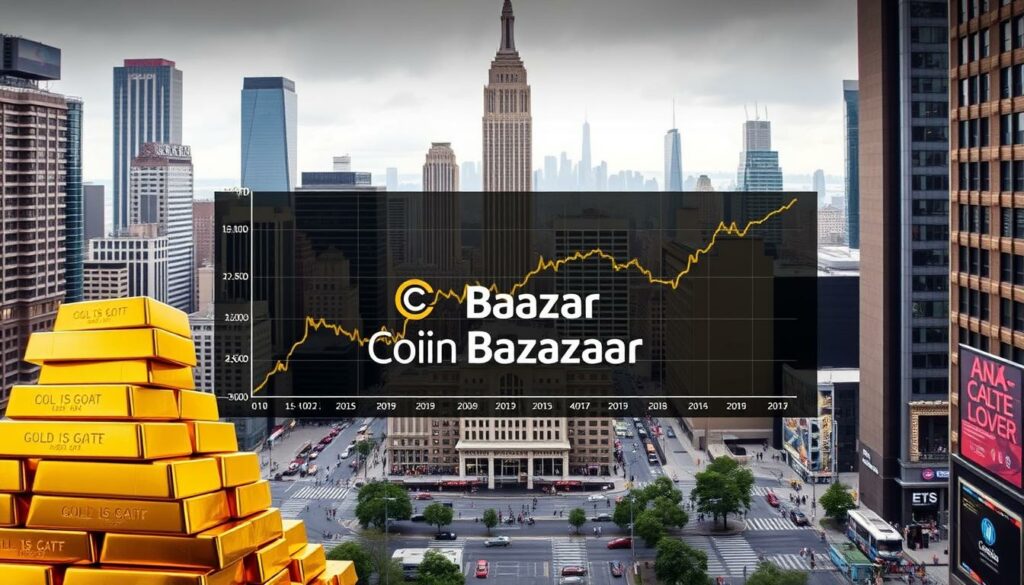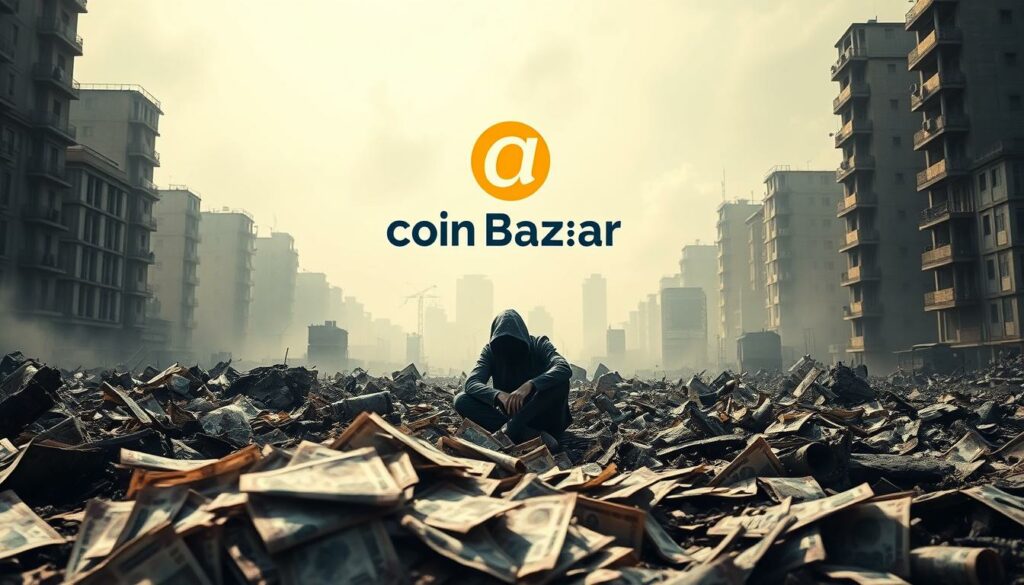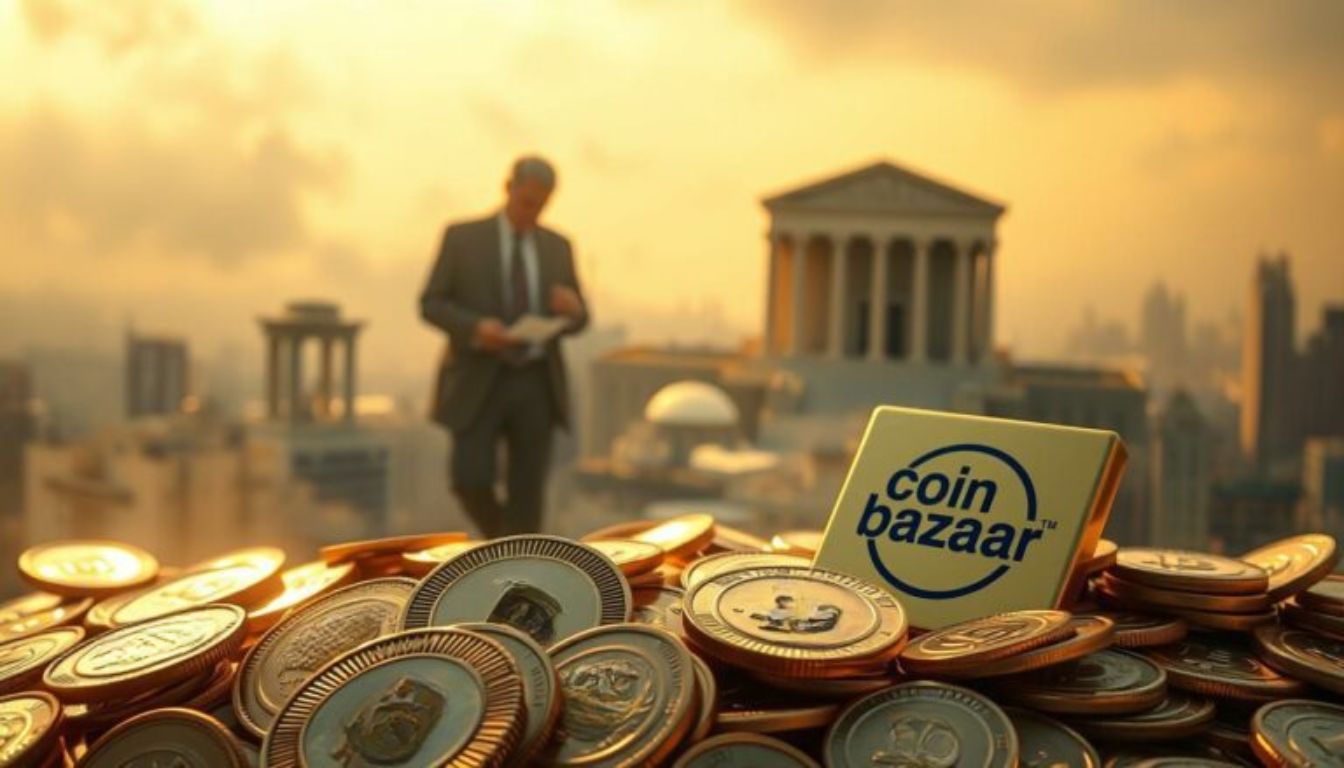Exclusive Deals & Trending Items
You’ve probably heard that gold investment is safe during tough economic times. But have you thought about how different investors see its role in their portfolios?
Central banks and retail investors have their own ways of using gold as a hedge against inflation. Central banks aim for long-term stability. Retail investors, on the other hand, often respond to short-term market changes.
Knowing these views can guide your investment choices during times of inflation.
Key Takeaways
- Central banks and retail investors have different investment goals and risk tolerance.
- Gold is traditionally seen as a store of value during inflation.
- Investment strategies vary based on market conditions and economic forecasts.
- Understanding these differences can inform your investment decisions.
- Diversifying your portfolio is crucial during economic uncertainty.
The Historical Relationship Between Gold and Inflation
Gold and inflation have a long history together. For years, gold has been seen as a shield against rising prices. Its success in fighting inflation is clear from past times.
Gold’s Performance During Major Inflationary Periods
Gold has kept its value well during big inflation times. For example, in the 1970s, when prices went up a lot because of oil, gold prices also went up. This shows gold’s important role in a portfolio.


Long-term Price Correlation Analysis
Research shows gold prices and inflation often go up together over time. When inflation increases, gold’s value usually goes up too. This helps keep investors’ buying power safe. But, this link can change in the short term because of market and economic factors.
Gold is great for keeping value safe. Adding gold to a mix of investments can help protect against inflation. So, knowing how gold and inflation have worked together in the past is key for smart investing.
Understanding Inflation and Its Impact on Your Wealth
Inflation and your wealth are closely linked. Knowing this can guide your financial choices. Inflation is when prices for things like food and housing go up. This means your money can buy less over time.
Types of Inflation and Their Effects
There are different kinds of inflation, each affecting your wealth in its own way. Demand-pull inflation happens when people want more than what’s available, making prices go up. Cost-push inflation occurs when it costs more to make things, also raising prices. Knowing these can help you get ready for inflation’s effects.
How Inflation Erodes Purchasing Power
Inflation makes your money worth less over time. As prices climb, you can’t buy as much as you could before. This is a big worry for people with steady incomes or those who haven’t planned for inflation.
The Hidden Tax: Calculating Your Personal Inflation Rate
Your personal inflation rate might be different from the national average. To find out, track your spending over time and compare it to the past. For example, if your spending went up 5% last year, your personal inflation rate is 5%, even if the national rate is lower.


Gold as a Hedge Against Inflation: Fundamental Principles
To understand why gold is seen as a safe haven, we must look at its value and history. Gold’s role as a hedge against inflation is based on several key principles.
Intrinsic Properties That Make Gold Valuable
Gold’s value comes from its unique qualities. Durability is one; gold doesn’t corrode and lasts a long time. This makes it a reliable way to store value. It’s also divisible and can be made into different forms, like coins and bars. This makes it useful for various investments.
Gold is also portable and recognizable, making it a popular medium of exchange and value storage.
As Warren Buffett said, “Gold is a way of going long on fear, and it’s been a pretty good business for a long time.” This shows how gold’s value is tied to human psychology.
Limited Supply and Consistent Demand Dynamics
The supply and demand of gold affect its value. Gold’s supply is limited, with new discoveries decreasing. This scarcity boosts its value. Demand for gold remains strong, for jewelry, investments, and industrial uses. This balance helps gold keep its value over time.
| Year | Gold Production (Tonnes) | Demand for Jewelry (Tonnes) | Investment Demand (Tonnes) |
|---|---|---|---|
| 2020 | 3,300 | 1,460 | 1,270 |
| 2021 | 3,560 | 1,540 | 1,070 |
| 2022 | 3,612 | 1,650 | 1,110 |
Gold’s Historical Role as a Store of Value
Gold has always been a store of value, a role it holds in many cultures. For centuries, it has helped preserve wealth for generations. Its importance is clear in how central banks and investors see it as a reliable asset during economic uncertainty.
In conclusion, gold’s role as a hedge against inflation is rooted in its intrinsic qualities, supply and demand dynamics, and its historical significance. Understanding these aspects helps us see why gold is a popular choice for investors looking to protect their wealth during inflation.
Central Banks’ Strategic Approach to Gold Reserves
As global economic uncertainties rise, central banks are increasingly turning to gold as a strategic reserve asset. This shift is driven by the need to diversify reserves and reduce dependence on dollar-denominated assets.
Global Trends in Central Bank Gold Purchases
Central banks have been consistently purchasing gold, driven by the desire to hedge against economic instability. According to recent data, central banks have been net buyers of gold for several consecutive years.
Case Studies: How Major Central Banks Use Gold
Major central banks utilize gold in their reserve strategies in various ways. For instance, some banks increase their gold holdings to signal economic strength and stability.
Diversification Away from Dollar-Denominated Assets
A key reason behind central banks’ gold purchases is the diversification away from dollar-denominated assets. By holding gold, central banks can mitigate the risks associated with currency fluctuations.
| Central Bank | Gold Reserves (Tonnes) | Percentage of Total Reserves |
|---|---|---|
| United States | 8,133.5 | 65.7% |
| Germany | 3,363.4 | 71.5% |
| Italy | 2,451.8 | 68.4% |
The strategic approach of central banks towards gold reserves is multifaceted, driven by the need for diversification and hedging against economic uncertainties. As the global economic landscape continues to evolve, the role of gold in central banks’ reserve strategies is likely to remain significant.
The Reserve Bank of India’s Gold Policy and Strategy
The Reserve Bank of India (RBI) manages its gold reserves carefully. It’s a key part of its overall strategy. The RBI’s gold policy helps keep the country’s finances stable.
Evolution of India’s National Gold Reserves
India’s gold reserves have changed a lot over time. This is due to economic factors and policy changes. The RBI has been growing its gold reserves to protect against economic risks, like inflation.
Some important changes include:
- Buying more gold to diversify reserves
- Managing gold to get the best returns and keep it liquid
- Updating the value of gold reserves to match current prices
Current Strategic Position in Global Context
India’s gold reserves are a big part of its foreign exchange reserves. They act as a shield against economic shocks. The RBI’s strategy for managing these reserves includes:
- Keeping the right balance of gold and foreign currencies
- Having enough liquidity to meet international payments
- Using gold reserves to protect against inflation, offering gold price protection inflation
The RBI’s proactive gold policy aims to make the country’s economy stronger. It provides a stable environment for investing in gold inflation hedge strategies.
Current Inflation Concerns in the Indian Economy
Understanding inflation is key for investors and consumers in India. The economy faces many challenges, including recent trends, the RBI’s actions, and how these affect people.
Recent Inflation Trends and Projections
Inflation in India has seen ups and downs. This is due to global prices, demand at home, and supply chain issues. Experts think managing inflation will be tough for the RBI.
The inflation rate is close to the RBI’s limit, causing worry. Rising food and fuel costs are big concerns. They affect how much people can buy every day.
RBI’s Monetary Policy Response
The RBI uses interest rates to fight inflation. They aim to control inflation while keeping the economy growing. This is hard with global economic issues.
| Year | Inflation Rate (%) | RBI’s Repo Rate (%) |
|---|---|---|
| 2022 | 6.5 | 4.0 |
| 2023 | 5.8 | 6.5 |
Impact on Indian Consumers and Investors
Inflation hurts Indian consumers by reducing what they can buy. It also affects savings. Investors look at gold as a way to protect their money from inflation.
With inflation still a worry, it’s important to understand it and how to protect your money. This helps make better financial choices.
How Retail Investors Approach Gold Investments Differently
Retail investors see gold differently than big investors. They are swayed by personal goals, how much risk they can take, and cultural values. Big investors look at the big picture and gold’s role in fighting inflation.
Psychological Factors Driving Individual Gold Purchases
Gold is more than an investment for many. It’s a safe place to keep money and a way to protect against bad times. The emotional appeal of gold comes from its rich history and being seen as a safe asset. When the economy is shaky or inflation is up, people buy more gold.
Cultural factors also play a significant role in gold investment decisions. In places like India, gold is a sign of wealth and is used in jewelry and cultural practices.
Differences Between Institutional and Retail Investment Strategies
Big investors spread their money around and use gold to balance risks. They see it as a way to protect against inflation or market ups and downs. But, smaller investors might put a bigger chunk of their money into gold. They see it as safe and easy to sell.
| Investment Characteristics | Institutional Investors | Retail Investors |
|---|---|---|
| Investment Goals | Diversification, hedging | Wealth preservation, cultural significance |
| Investment Horizon | Long-term, strategic allocation | Variable, often short to medium-term |
| Investment Vehicles | Gold ETFs, futures, bullion | Physical gold (jewelry, coins, bars), digital gold |
It’s key for financial advisors and policymakers to know these differences. This helps them give better advice and make policies that work. As the world of investing changes, understanding these differences helps create better products and plans.
Gold in Indian Households: Beyond Investment
Gold is highly valued in Indian homes, going beyond its monetary worth. It’s a key part of cultural and traditional practices. For many, gold represents prosperity, good fortune, and cultural heritage.
Cultural and Traditional Significance of Gold
Gold has been a big part of Indian culture for centuries. It plays a key role in many rituals, ceremonies, and celebrations. It’s a tradition to gift gold during weddings and other auspicious occasions, showing good luck and prosperity. Gold’s cultural importance is deeply rooted, making it a vital part of Indian heritage.
In many Indian homes, gold is seen as a family heirloom, passed down through generations. This keeps family wealth and cultural traditions alive.
Trends in Physical Gold Ownership Across Demographics
Physical gold ownership is common across different groups in India. A survey shows that gold is a preferred asset class, valued for its investment potential and cultural significance.
- Young couples often buy gold coins or jewelry as a symbol of prosperity during weddings.
- Middle-aged individuals invest in gold as a hedge against inflation and economic uncertainty.
- Senior citizens prefer physical gold as a store of value and a way to pass wealth to the next generation.
Gold’s Role in Indian Family Wealth Preservation
Gold is crucial for preserving family wealth in India. It’s seen as a safe haven during economic downturns and a hedge against inflation. Gold’s liquidity and ability to retain value make it attractive for wealth preservation.
Wedding Gold: Investment or Expense?
The tradition of buying gold during weddings is significant in India. While it’s often seen as an expense, it can also be viewed as an investment. Gold’s tendency to appreciate in value over time makes it valuable.
“Gold is a unique asset that combines cultural significance with economic value, making it a valuable component of Indian family wealth.”
As the cultural and economic landscape changes, gold’s role in Indian homes remains significant. Understanding its cultural, traditional, and economic value is key for investors and those looking to preserve family wealth.
Your Gold Investment Options in India
India has many gold investment options to protect against inflation. You can choose from different ways to invest in gold. Each option has its own benefits and fits different investor needs.
Physical Gold: Jewelry, Coins, and Bars
Buying physical gold is a common choice in India. You can find gold jewelry, coins, or bars at local jewelers or banks. Coins and bars are better for investing because they are pure and have lower costs.
Digital Gold Platforms and Gold Accumulation Plans
Digital gold platforms let you invest in gold online. You don’t need to store physical gold. You can buy small amounts of gold over time with Gold Accumulation Plans (GAPs). These platforms offer insurance and are easy to use.
Gold ETFs and Mutual Funds in the Indian Market
Gold Exchange-Traded Funds (ETFs) and mutual funds let you invest in gold without owning it. Gold ETFs trade on stock exchanges and follow gold’s price. Mutual funds that focus on gold or gold-related assets offer a diverse investment choice.
Sovereign Gold Bonds: Features and Benefits
The Sovereign Gold Bonds (SGBs) scheme is backed by the government. It lets you invest in gold through paper. SGBs come with a fixed interest rate, tax benefits, and are issued by the RBI on behalf of the Government of India.
Knowing about these gold investment options helps you make smart choices. Whether you like physical gold, digital platforms, or financial products like ETFs and SGBs, there’s a gold investment that suits you.
Statistical Evidence: Does Gold Really Protect Against Inflation?
Looking at the numbers is key to figuring out if gold is a good shield against inflation. We need to check how gold has done over different periods and under different economic conditions.
Short-term vs. Long-term Correlation Analysis
Research shows that gold’s link to inflation changes based on the time frame. In the short term, gold’s price can swing wildly, not always matching inflation. But, over the long term, gold tends to keep pace with inflation, showing it can be a solid hedge.
| Time Frame | Gold Price vs. Inflation Correlation |
|---|---|
| Short-term (1-3 years) | Variable, often influenced by market sentiment |
| Long-term (10+ years) | Generally positive, reflecting gold’s role as an inflation hedge |
Performance During Different Economic Cycles
Gold’s role as an inflation shield also depends on the economy’s state. When high inflation hits, gold usually shines, attracting investors looking for safe havens. But, in low inflation times, gold’s appeal drops, leading to weaker returns.
India-Specific Gold-Inflation Relationship
In India, gold is often seen as a safe bet, especially when the economy is shaky or inflation is high. Historical data shows gold has acted as a buffer against inflation in India. Yet, local market and cultural factors can sway this relationship.
By grasping these factors, you can better decide if gold is right for your portfolio as a defense against inflation.
Limitations and Risks of Using Gold as an Inflation Hedge
Gold is popular for fighting inflation, but it comes with risks and limits. Knowing these can help you make better investment choices.
Price Volatility Concerns
Gold’s price can change quickly, making it hard to guess its short-term value. For example, during market stress, gold prices might rise. But, they can also fall fast if people’s views change.
Storage, Insurance, and Maintenance Costs
Buying physical gold means extra costs for storage, insurance, and upkeep. These expenses affect your gold investment’s total return. Safe places to store gold, like safe deposit boxes, can be pricey. Insurance helps protect against loss or theft.
Liquidity Challenges in Different Market Conditions
Selling physical gold can be tough, especially in bad market times or when you need cash fast. It’s important to think about how easy it is to sell your gold and plan ahead.
To lessen these risks, diversifying your gold investments is a good idea. You can use digital gold platforms, gold ETFs, or Sovereign Gold Bonds. Each has its own benefits and risks. You should weigh these based on your financial goals and how much risk you can handle.
Comparing Gold to Other Inflation Hedges Available to Indian Investors
Gold is a popular choice against inflation, but it’s not the only option for Indian investors. Knowing the other choices is key to protecting your wealth.
Real Estate in the Indian Context
Real estate is a favorite investment in India, seen as a shield against inflation. It usually grows in value, keeping up with or beating inflation. But, think about the challenges like liquidity, management, and market ups and downs.
Inflation-Indexed Bonds and Government Securities
Inflation-indexed bonds from the Government of India adjust returns for inflation. This keeps your investment’s value steady. They’re great when inflation is high. Yet, their returns might be lower, and you must hold them until they mature to see the benefits.
Equity Markets as Long-term Inflation Protection
Investing in equity markets can also fight inflation over time. Stocks have often beaten inflation, even if they can be shaky short-term. Spreading your investments across different areas can lessen risk. Some sectors, like consumer goods, do well when prices rise.
Gold, real estate, bonds, and stocks each have their own pluses and minuses. Gold is liquid and a classic value holder but doesn’t earn income. Real estate offers income and growth but requires upkeep. Bonds give steady, adjusted returns, while stocks promise long-term growth but are riskier.
Tax Implications of Gold Investments for Indian Taxpayers
As an Indian investor, knowing the tax rules for gold is key. Gold investments, whether physical or digital, have different tax rules.
Physical Gold Taxation: LTCG and Wealth Tax Considerations
Investing in physical gold means you need to think about taxes. If you hold gold for over three years, gains are long-term capital gains. These are taxed at 20% after adjusting for inflation. Also, if your wealth, including gold, is too high, you might face wealth tax.
Digital Gold and Paper Gold Investment Taxation
Digital or paper gold, like Gold ETFs or Sovereign Gold Bonds, have their own tax rules. Gains from Gold ETFs are taxed like stocks. But, Sovereign Gold Bonds are tax-free if held until maturity.
Recent Tax Policy Changes Affecting Gold Investors
New tax policies have changed things for gold investors. For example, tax on long-term capital gains from listed securities affects Gold ETFs. Keeping up with these changes helps you make smart investment choices.
When investing in gold, remember to consider taxes. This way, your investment decisions will be more tax-friendly. Knowing the tax rules helps you manage gold investments in India better.
Building Your Inflation-Protected Portfolio with Gold
Inflation can harm your investment portfolio. But, adding gold can protect your wealth. It’s key to know how to allocate, rebalance, and mix gold with other assets.
Optimal Allocation Strategies Based on Age and Risk Profile
The right amount of gold in your portfolio depends on your age and how much risk you’re willing to take. A 5-10% allocation to gold is a good starting point for many. But, it can change based on your personal situation.
| Age Group | Risk Profile | Recommended Gold Allocation |
|---|---|---|
| 20-40 | Aggressive | 5% |
| 40-60 | Moderate | 7.5% |
| 60+ | Conservative | 10% |
Rebalancing Considerations During Inflationary Periods
When inflation is high, it’s important to rebalance your portfolio. This means selling some assets and buying gold to keep your desired mix. It helps keep your portfolio balanced.
Combining Gold with Other Asset Classes for Maximum Protection
Gold works well with other assets like stocks, bonds, and real estate. Together, they make a diverse portfolio that fights inflation well. A diverse portfolio helps you handle market ups and downs and reach your financial goals.
Future Outlook: Gold in an Evolving Economic Landscape
The future of gold investment is closely tied to changes in global and Indian money policies. It’s important to understand these changes when thinking about investing.
Potential Impact of Global and Indian Monetary Policies
Monetary policies worldwide and in India greatly affect gold’s investment appeal. Central banks’ decisions on interest rates and money printing can change gold prices. Keep an eye on these changes.
Global Monetary Policies: The actions of major central banks can make gold more attractive as a safe asset.
Digital Currencies vs. Traditional Gold Investment
The growth of digital currencies is changing the gold investment scene. Digital currencies offer a new choice, but gold’s traditional value is still strong. You might want to spread your investments across both.
Emerging Market Demand Projections
Emerging markets, like India, are set to boost gold demand in the future. Cultural importance and growing wealth in these areas keep gold’s appeal alive.
| Factor | Impact on Gold Investment |
|---|---|
| Global Monetary Policies | Influences gold prices through interest rates and quantitative easing |
| Indian Monetary Policies | Affects gold demand through economic stability and currency fluctuations |
| Digital Currencies | Offers an alternative investment option, potentially impacting gold demand |
| Emerging Market Demand | Drives gold demand through increasing wealth and cultural significance |
It’s key to understand these factors to make smart choices about gold in your portfolio. This helps protect against inflation.
Common Mistakes to Avoid When Investing in Gold
When thinking about gold as a shield against inflation, it’s key to steer clear of common errors. Gold can be a smart choice, but it needs careful thought and planning.
Timing the Market Instead of Time in the Market
Many investors try to catch the perfect moment to buy or sell gold. But this focus on short-term gains can lead to missed chances and lower profits. Gold’s long-term track record shows it’s better to invest for the long haul.
Overlooking Making Charges, Premiums, and Exit Loads
When buying physical gold, like jewelry or coins, remember the extra costs. These can greatly affect your investment. Also, when investing in gold ETFs or mutual funds, watch out for fees when you sell early. Knowing these costs helps you make better choices.
Authentication and Purity Verification Issues
It’s also vital to check the gold’s authenticity and purity. Whether it’s coins, bars, or jewelry, make sure they’re certified by trusted places. This step is key to avoid fakes and ensure your gold is genuine.
By knowing these common mistakes, you can better navigate the gold investment world. This way, your gold investment can be a strong defense against inflation.
Conclusion: Balancing Gold in Your Personal Inflation Protection Strategy
Gold can be a key part of your plan to fight inflation. It’s important to know how gold and inflation have worked together in the past. This knowledge helps you decide how to use gold in your investments.
Gold is a strong choice to protect against inflation, especially when used with other investments. Think about your financial goals, how much risk you can take, and when you need your money. Adding gold to your portfolio can help keep your money’s value steady over time.
Having a mix of investments, including gold, can help you deal with inflation’s challenges. When looking at gold investments, consider the pros and cons of each option. This includes physical gold, digital gold, and gold ETFs. Choose what works best for you.




















